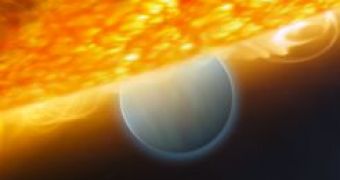New theory says that planets known as “hot Jupiters” are unlikely to have moons that form around them because of the star's gravitational sphere of influence, according to astronomer Fathi Namouni of the University of Nice in France.
A hot Jupiter is born in the cold outer regions of its solar system and it has a migration phase toward its star, that “lasts roughly 100,000 years” and during which “the moons that form around the planet get ejected,” explains Namouni.
Until recently astronomers have found hundreds of giant planets circling other stars and they kept searching for moons orbiting these planets, unsuccessfully.
Their theory that such moons should exist was based on characteristics of Jupiter, Saturn, and Neptune, the sun's three giant planets, and they even proposed observing hot Jupiters that transit or pass in front of their stars.
Namouni contradicts everything in his paper appearing in the August 20 issue of The Astrophysical Journal Letters, where he models a gas giant that becomes a hot Jupiter by moving toward its star.
In this model, at the beginning the planet has four moons, just like Jupiter but the closer it gets to the star, the more moons it loses, as the star's gravitational sphere of influence intrudes on the planet's and throws the outermost three of them into extended orbits around the star.
As the fourth and last moon crashes into the planet, the hot Jupiter is totally moonless, Science NOW reports.
There are however hot Jupiters that have moons, but Namouni says that “these moons must have been captured later, much like Triton around Neptune,” because they have backward orbits.
Namouni's work is somehow countered by astronomer Jason Barnes of the University of Idaho, Moscow, who says that the work does not go far enough as moons that migrate toward their planets and ultimately crash into them exist, and the resulting material orbiting the planet can form new moons.
On the other hand astronomer David Kipping of the Harvard-Smithsonian Center for Astrophysics in Cambridge, Massachusetts says that “Namouni has concisely demonstrated what previously had been suspected but never formally proved: that hot Jupiters are unlikely to hold onto moons during the migration process.”
He adds that even in our solar system, Mercury and Venus do not have moons, but is hopeful that the Kepler spacecraft will one day find extrasolar moons.

 14 DAY TRIAL //
14 DAY TRIAL //